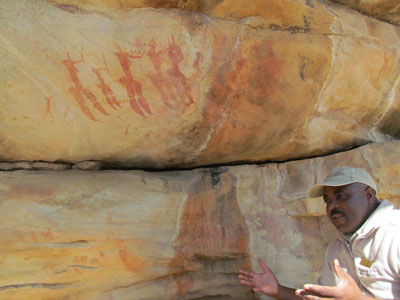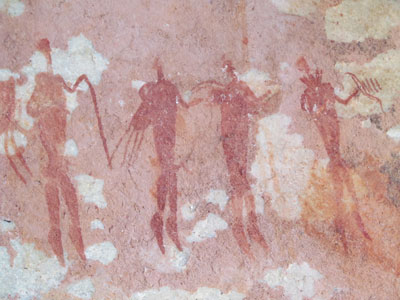The rock art of Bushmans Kloof
This item appears on page 53 of the May 2016 issue.
One hundred sixty miles north of Cape Town, South Africa, lies Bushmans Kloof, one of the most unique art galleries I’ve ever visited. It’s extraordinary both for its immense size and for the antiquity of its paintings.
Paintings that are 2,000 to 10,000 years old are scattered among more than 130 caves and rock overhangs in the Cederberg Wilderness area of western South Africa. These rock paintings have been called one of the largest open-air art galleries in the world.
The San people
Although there is a difference of opinion among archaeologists and anthropologists on whether Homo sapiens evolved in Southern or Eastern Africa (with the majority leaning toward Eastern Africa), fossil footprints that are more than 120,000 years old were discovered only 20 years ago about 60 miles from Bushmans Kloof. This makes Southern Africa a contender for the title of “cradle of modern mankind.”
Eventually, however, Homo sapiens left his African birthplace to journey to other parts of the globe. Those who stayed in Southern Africa were the southern San people, or /Xam (pronounced “tsum”), as they called themselves. They were probably the ancestors of the rock art painters of Bushmans Kloof.
These San people were hunter-gatherers. Their complex system of spiritual beliefs included shamans who induced trance-like states in themselves that produced out-of-body experiences. Some of these trances are depicted in the rock art.
About 2,000 years ago, the San-/Xam were displaced in a 2-pronged migration by the Khoekhoen, sheepherders from the northeast, and the Nguni, cattle herders and farmers from the northwest. The San managed to survive in what is present-day South Africa until the arrival of Europeans in the 17th century, when they were enslaved or eliminated.
By the mid-19th century the southern San — those who had created the rock art — were extinct. Only their superb art remained.
Londi, our guide, told us that, of the 130 rock art sites at Bushmans Kloof, visitors are usually taken to one or more of nine sites. My husband, Paul, and I were to visit three during our three days at Bushmans Kloof in May 2015.
Types of sites
Rock art sites at Bushmans Kloof are divided into habitation sites, those that could shelter a small group of people, and shaman sites, those that could hold only one or two people and were probably used for shamanistic rituals.
Habitation sites often depicted processions, perhaps those of the inhabitants of a particular cave or overhang, while shaman sites depicted trance paintings, sometimes portraying out-of-body experiences or transformations into animals. Some sites were a combination of both: shaman sites that were also habitations.
The first two sites we visited were habitation sites.
CHARLIE BROWN — Charlie Brown (we never did discover how it got its name) is an easily accessible site that depicts two separate processions of females with exaggerated anatomical features, apparently to make sure one didn’t mistake their gender.
This is one of the rock art sites that was a habitation but might also have been used by a shaman, possibly for female initiation ceremonies.
FALLEN ROCK — More difficult to reach and requiring some scrambling over rock and boulders is the Fallen Rock site. It’s aptly named. At some unknown time in the past, a slab of cave wall with paintings on it fell. Other rocks now hold the fallen slab in place above the ground. Visitors have to crawl beneath to see the paintings, although there are other rock paintings to see that are not under the fallen slab.
There are groups of people portrayed, including one showing figures bundled up in coverings or blankets with their bags, perhaps used for gathering food or for hunting, arranged neatly above their heads. The floor of the cave is pictured beneath them.
The most interesting of the paintings is a tall figure with parallel lines extending from its nose (to indicate a profuse nosebleed) and with a pair of legs emerging from its back. Both indicate an out-of-body experience, the result of a trance.
This cave, too, could have been used for habitation and for shamanistic rituals.
BRANDHOEK — The last site we visited was the easily accessible Brandhoek, a small shelter that was probably a shaman site. What stands out there is the female figure carrying sticks and wearing thongs around her torso. She appears to be looking behind her as she marches forward.
These three rock art sites gave us a taste of what lies in other caves and overhangs on the vast Bushmans Kloof property.
Bushmans Kloof
Bushmans Kloof Wilderness Reserve & Wellness Retreat (P.O. Box 582, Cape Town 8000, South Africa; phone +27 [0] 21 437 9278, www.bushmanskloof.co.za) offers guided rock art excursions to those who stay there. It’s the only way to see the rock art sites on the property.
Paul and I went for the rock art, but Bushmans Kloof offers much more: nature drives, fishing, canoeing, superb dining and wine tasting as well as just plain relaxing. There is also a spa.
Rates vary depending on season. During low season (April through August), when we went, rates range from ZAR2,950 to ZAR5,455 (near $197-$365) per person per night for a double room. This also includes all meals, afternoon high tea, the varied activities and taxes. Rates are higher during high and peak seasons.
Our only mistake was that we stayed just two nights. We wished it had been at least three or four.
If you go…
Bushmans Kloof offers a car service for visitors. Not including the tip, it cost ZAR6,000 ($357), round trip from Cape Town. It was expensive but was well worth it to us not to have to rent a car for the 160-mile, 3-hour drive each way.
If your time in Cape Town is limited and you can’t fit in a trip to Bushmans Kloof, then head for the Iziko South African Museum at 25 Queen Victoria Street (phone 027 21 481 3800). Besides photos of rock art sites, there’s the superb Linton Panel, rescued from a rock shelter in 1918. It depicts shamans in a trance and a herd of elegant eland, animals considered sacred by the San.
Finally, if you do visit Bushmans Kloof and want even more rock art, visit Traveller’s Rest (phone 027 27 482 1824, www.travellersrest.co.za), a farm adjacent to Bushmans Kloof.
There is a self-guided, 3-mile-long trail, the Sevilla Trail, that visitors can follow to see nine rock art sites. You can hike the trail even if you’re not staying at either Bushmans Kloof or Traveller’s Rest. The entry fee for the trail is ZAR40 ($2.68).



